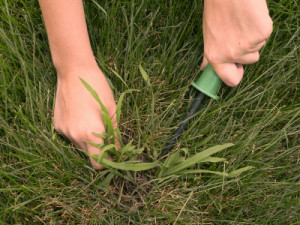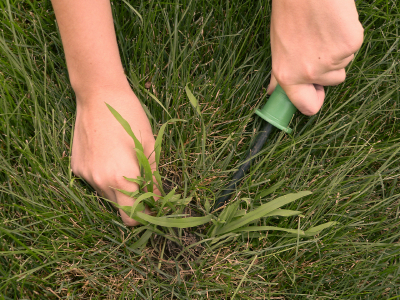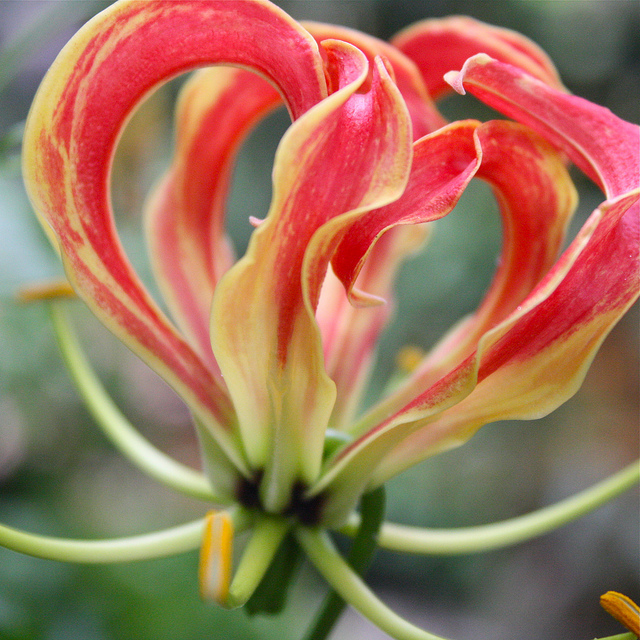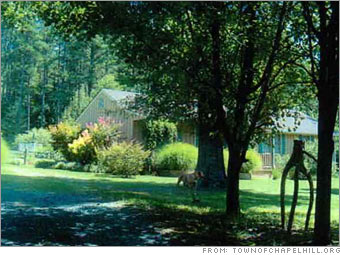Gardening for Everyone
It’s Spring, and a Young Middle-Aged Man’s Thoughts Turn to Love Weed Control
Donald McInnes, Ph.D.
Working in the Richland County Extension Office I get all sorts of questions—from how to fertilize roses, to what grass makes the best lawn, to how to control moles, to where are the bodies buried. That last one was just to see if you’re paying attention—I’ve never been asked to disclose the location (I have, however, been asked how to kill the insects attracted to certain crime scenes).
This time of year lawn questions dominate. Most folks don’t think much about their lawns after they stop growing in the fall until they notice how well the annual weeds have thrived over the winter or they discover some spots are failing to green-up in the spring.
The Extension Office gets dozens (maybe even hundreds) of cries for lawn help (“HELP!”) every week this time of year. I want to offer you a few thoughts on controlling weeds in your lawn.
Many lawn care chemicals have been associated with environmental and human health problems. According to Beyond Pesticides, 17 of 30 of the most common lawn pesticides have been linked to cancer, 11 to birth defects, 19 with reproductive effects, 24 to liver or kidney damage, 14 with nerve damage, and 18 to endocrine disruption. Children are most at risk. Because of this, some governments have outlawed the aesthetic use of toxic pesticides.
Without routinely using chemicals, your lawn is going to have some weeds in it. They’re unavoidable—because they spread by seeds floating in on the wind, or washed in by rain water, or being pooped out by animals, or carried in by machines or even on the bottoms of people’s shoes.
If you want to minimize the use of toxic chemicals, one thing you can do is adjust your attitude and expectations. The lawn does not have to be perfect; a few weeds will not incur the wrath of your neighbors or get you cited by the neighborhood association. Most people won’t even notice.
Know your weeds. If you want to control weeds, it pays to know your enemy. Different weeds require different control strategies. The University of Missouri has an online weed key that’s a good place to start. You can also take samples to your local Extension office, the USC Herbarium, or to a local nursery. Once you’ve got an ID for your weeds, you might want to consult a good book or website (here’s another), or call in an expert.
Hand-pulling is one of the best things you can do for weed control. Unlike poisons, hand-pulling removes the seeds, and therefore, reduces your future weed problem.
If hand-pulling is too labor intensive, use your mower. The more often you mow, the better. Just cutting down weeds before they have a chance to reproduce will lessen the problem in the future. It will also help things look better—the even height of a lawn is perhaps its most appealing characteristic and that most disturbed by weeds. If you’ve got a lot of weeds going to seed, use the bagger on your mower to collect the clippings (something not recommended at other times).
The best defense against weeds in your lawn is a thick, lush, competitive lawn. Do all you can to make conditions optimal for your lawn grass to thrive. Fertilize and lime according to soil test results. Water and mow as your soil and the weather dictate. Aerate and topdress as needed. (See the factsheets here.)
If you can’t make conditions optimal, especially light conditions, it might be time to abandon turfgrass in that area. Our lawns thrive best in full sun. Even the most shade tolerant of the grasses we can grow, St. Augustine, needs no less than several hours a day of direct sun to thrive. Grasses under stress from too much shade (or too much wear and tear, or too little water, or too much soil compaction, etc.) will gradually become thin and sparse, and weeds will then take advantage of the vacant ground. On the north side of buildings and large trees, shade is particularly problematic. Here you might consider trading a struggling lawn for hardscaping or a lush woodland landscape (do an image search on “woodland landscape” or “shade garden” for hundreds of ideas).
Don has degrees in biology from Duke, Northwestern and Florida State. He has worked for Clemson Extension in Richland County since 2000, assisting thousands of consumers with landscape, garden, wildlife and pest control questions. He is also the owner of Southeastern Environmental Design, a landscape coaching, consulting and design service. He’d be happy to help you master your landscape.






I’ve tried EVERYTHING to get rid of the voles in my yard – from poison pellets, chewing gum, moth balls, etc. They have literally taken over my yard with tunnels. WHAT CAN I DO?????????